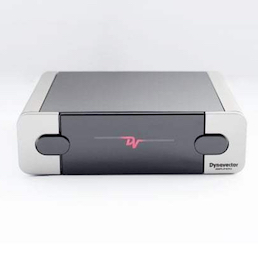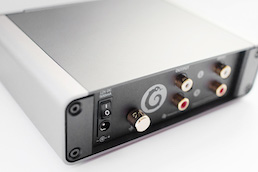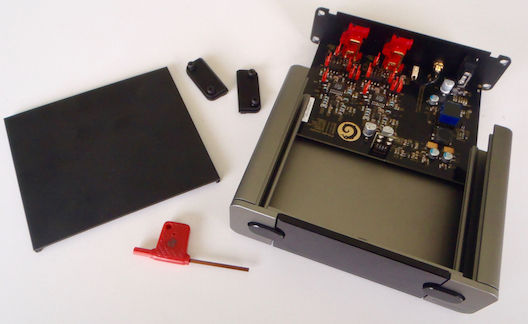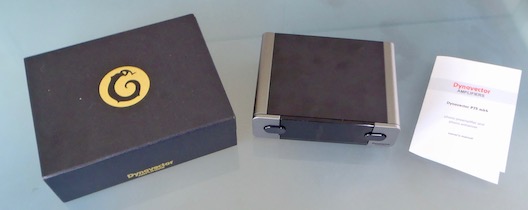The Dynavector P75 Mk3 Phono stage - NZ$ 1250
The Dynavector P75 has been the go-to phono stage in New Zealand since it's introduction in 2003. Over time we've seen a series of significant upgrades and now we're thrilled to introduce you to the MK4.

The new Dynavector P75MK4 is the most substantial re-working of the design with by far the greatest advance in performance. Outwardly the P75MK4 has been transformed from a very basic little box to a much more sophisticated construction, with curved aluminium extrusion sidepanels, a more appealing front and far better finish.
The rear panel now has a on/off switch and allows access to the internals (for adjustment) via 4 allen head bolts for which a key is supplied. The earth terminal is also improved. Overall it feels more substantial and has better damping which reduces micro-phony.
As with previous versions, there are a series of user adjustable jumpers which allow adjustment for cartridge type, gain and impedance. There are also a pair of easily accessed micro-switches for adjusting MM gain. The manual has been improved to make all fine tuning easier.
While we've known the new MK4 version was coming for over six months, when it finally turned up, I was occupied with listening to other new products so it had to take a back seat. Now I'm kicking myself for not getting straight to it as it's really quite something...

Of all the generations of the Dynavector P75, the new MK4 version represents by far the greatest gain in performance and build quality. In the past the P75 in MK1,2 and 3 forms was always seen as a very good value for money option with minimalist casework and some very cool ideas inside. Now we have a phono stage with sound quality and finish that is up with the very best no matter what cost and while the price for MK4 is above the MK3, the value for money equation is far better with the new model.
I first listened the the Dynavecter P75MK4 in MM mode connected to a Well Tempered Simplex 2 turntable fitted with the cheap and cheerful Nagaoka MP110 moving permalloy (MM) cartridge. The internal gain switch on the P75 was switched to high as the Nagaoka is noted for very low surface noise levels and I was after the extra dynamics.
Even from brand new it was obvious that there had been a significant lift in sound quality from the MK3 version. Previously I'd felt that the Well Tempered RIAA phono stage had the better of the Dynavector (and for those in the know, there is some common heritage) although the WTL RIAA is MM only. But now, the Dynavector was clearly ahead on all counts - this became even more pronounced over the first few hours of running.
I'd previously attributed some of the slightly rough and ready loose ends of the sound to the low cost of the Nagaoka, but this evaporated - the sound was smoother and with much more balanced bass, surface noise dropped right down and a level of detail I'd previously not thought possible from such a humble cartridge was laid bare. Sound-staging was dramatically improved and what was supposedly and entry level turntable system was starting to work at a suspiciously high end level.
The subtleties of lead-out tracks as songs decayed away were striking and there are often previously unheard sections hiding in what we used to think was a soundless gap.
We continued to enjoy this combination for a few days - I was struck by just how good it was relative our normal analogue system and how it got to the heart of music so easily. All I want to do is listen to some of our better MMs now - the Nagaoka MP150 and the Well Tempered TLC - as I can hear that we have now found our best solution for these - and this gives us a much better series of options for many of our clients who have rather nice turntables fitted with MM cartridges.

But there is a lot more to the new Dynavector so let's consider the MC performance options.
For many years we has a strong attachment to a Rotel Michi RHQ-10 phono stage - a full sized and extravagantly expensive (at the time) unit. The first two P75s were good, but not at this level. The Mk3 did prove to be better but at about the same time the Pure Audio Vinyl phono stage landed and there was no doubt as to the superiority of the much larger and more costly model. The Pure Audio is for low output MC only whereas the Dynavector does duty with both types of cartridge - how does the MK4 stack up?
A big part of what makes the Dynavector P75 special is the PE - Phono Enhancer - Mode. This goes back to the first model and is still in the new MK4. The Phono Enhancing Circuit was originally designed by Dr Tominari (who is behind all the Dynavector cartridges).
This mode gets rid of the input resistor, found in almost all other phono-stages, and configures the P75 to act as a current amplifier. The result is that the coils of the cartridge see an effective short circuit as load, the ideal condition. Within the Phono Enhancer mode there are three gain settings but the actual gain level achieved in this mode is dependent on the output impedance of the cartridge.
My own Dynavector DV20XL2 has a specified DC resistance of 5 ohms - this is not the cartridge loading resistance which is often much higher so carefully check the literature to find the right value for your own cartridge.
There is no doubt that for all the Dynavector cartridges, this is the way to go - this is what a reviewer found with one of the earlier versions....
"I switched the P75 over to Phono Enhancer mode. Cripes, what a difference! I was obviously expecting a different sound and in this assumption I was partly wrong andpartly underestimating the differences. Phono Enhancer or Dr. T. mode lifts thisstage’s sound quality to new levels and price brackets. The sound produced is still characterised by the great dynamics, neutral rendition and ease of listening shown in the other modes. In other words it’s still the same phono-stage, but it is simply a better version. You can dissect the changes wrought by moving a few jumpers; more bass with even better control, more detail - but it’s the way these things are incorporated into the whole picture that so impresses me in the standard gain modes. Phono Enhancer does an even better job." HiFiPlus issue 30.
For other low output MCs it's really a case of trying the P75MK4 in both standard and PE modes to see which works best for you. For myself, I just went straight to PE mode.
This is clearly not the earlier MK3 I remember - there has been a quantum jump in performance - the reduction of noise floor, better retrieval of detail, immediacy and precision. These qualities are such that they better the performance of our previous reference in many ways. The music literally came alive in a way I wasn't expecting.
Now I'm torn. I love the Pure Audio because it was clearly the best when I first listened to it - the build is fabulous and it's a totally analogue product in the best sense, being fluid and relaxed yet able to fill a room with soundstage. Everything is there like a landscape spread out in front of you. On balance it still has the edge on the Dynavector but the gap between the two is dramatically narrowed. And physically, the Pure Audio is much more substantial - the differential in price is clearly displayed in the no-compromise engineering of the Pure Audio with separate PCBs and power supply sections for each channel.
But the new Dynavector P75MK4 is even better in some areas of sound - the micro detail of individual sounds buried deep in a mix, the snap and pace of percussion. It's lighter, faster and more immersive. This is a remarkable progression from the MK3 which was comprehensively bettered by the Pure Audio. To be fair, the Pure Audio is also an effectively bespoke product and while I am listening to a standard off the shelf unit, they can be optimised for the specification of any low output MC. The Pure also proves to still be slightly better in noise rejection also I know almost all the residual background in our system is from lighting noise breaking in via the arm leadout cables and I'm getting really picky. Again - I will emphasise my comparison is made using a Dynavector DV20X2 in PE mode which makes the new Dynavector P75MK4 rather stunning value should you have a system like this.

While going back over the earlier P75 versions I'm quite surprised by how basic the first iterations now appear to be in hindsight - little more than simple tin boxes and while the reviews were great and the price low, they hardly looked or felt like high end products.
The new Mk4 changes this - the outer packaging is now just as good as the more costly Dynavector MC cartridges. As you can see from the pictures, the casework and finish of the phono amplifier itself is of the standard we expect with high end components. It literally looks as good as it sounds.
The latest version of the Dynavector P75 manual is worth reading - especially if you get the phono stage - it is clear and easy to understand with illustrations covering all possible adjustments so you are not reliant on me to perform some act of black magic to set it up. It is worth quoting as a model of clarity and intention, not to mention a few wise words....
"The P75 solves most cartridge/phono matching issues by presenting the cartridge with a constant, purely resistive load right across the audio band and beyond. This allows all cartridge types to perform at their best. It also has far superior rejection of common-mode noise than other phono amplifiers making it less susceptible to interference and noise. Analogue playback systems can produce amazing, like-like sound quality. They do need a little more care and attention and small changes can make a big difference. Our best advice, even in this online world, is to find a great local HiFi dealer and build a long-term relationship with the. They can transform the sound in your home."
The Dynavector P75MK4 operates on a 12v DC input - this can be from the supplied plug in unit, or dedicated supplies such as those found with the Well Tempered Turntables. Essentially any 12v supply will work but we have found that some of the cheaper units can create hum via the turntable arm or arm leads so best to use at least the supplied unit.
One of the key internal changes over previous units is the introduction of a new ultra low noise power supply that is electrically isolated from the input power. It takes the low grade single 12 volt input and converts it to dual high voltages to amplify the signal from your phono cartridge.
Because the P75MK4 does not have any mains frequency (or other low frequency components) in the power supply, this new version eliminates many of the hum problems that conventional mains coupled phono stages are plagued by.
As noted above, there can be other sources of hum - because we know it's not the P75 producing this, these are much easier to track down - modems, cordless phones and many plug in charging devices are common culprits. Some halogen and LED light fittings can also contribute to noise. To remove hum, there is usually ground lead from your turntable - this should normally be connected to your amplifier - not the P75. The earth terminal on the P75 is normally not required but can be connected to a ground point if there are loop or ground issues with other components in the system.
While the MK4 is made in Australia the several important designers are involved - Dr Tominari from Dynavector Japan is responsible for the 'Phono Enhancer' which is at the heart of the P75's performance. Frank Denson - the New Zealand Dynavector distributor should be credited with making the P75 happen in the first place and Jonathan Davis of Dynavector Australia has bought this long running project to it's present highly evolved culmination. The late John Bevan Ford also assisted with the appearance and functional design and the packaging is effectively a tribute to him.
With previous versions I was always equivocal on the merits upgrading from one Dynavector to another - the changes made were incremental. But the Mk4 is a whole different ball game - it's much better in all regards and so any existing MK1 - 3 owner can be confident it is a worthwhile upgrade - you'd get a much better looking and performing product. The higher price also helps hold up the value of older units.
The performance of the Dynavector P75MK4 will be nothing short of a revelation for almost all turntable owners.
It is the best sounding unit I have every heard on MM and the combination of this and a well chosen cartridge such as the Nagaoka or Well Tempered models, Sumiko or Ortofon will rival or best most MC/Phonostage combinations for the same or lower total cost.
For any Dynavector low output MC owner, this latest version running in phono enhancer mode will be near on impossible to beat at any price - given the cost of the P75MK4 is less than any of the MC models this makes it a veritable no-brainer. Even your interconnects are quite likely to cost more.
With other moving coil brands, the Dynavector P75MK4 should be at the top of your list - there are a good number of reviews of previous models with various different cartridges that you can search out. The easily adjusted internal jumpers allow you to optimise the P75MK4 for almost any cartridge and there is the ability to fit custom resistor and capacitor loading (the whole internal board simply slides out to allow this). And for many of these cartridges, the PE mode will prove to be beneficial.
There are probably more phono stages out there for sale than there have been at any time - but none have the heritage of the Dynavector, very few have seen the sustained development and refinement. Dynavector are one of the very few companies to design and manufacture both cartridges and amplifiers so have an understanding of the requirements of both disciplines which combine in a phono stage. There are a lot of considerably more costly units but you can't take it as a given that they are going to sound as good. And I can certainly assure you as a long time turntable enthusiast, there is nothing cheaper that even comes close.
The sound of the Dynavector with both MM and MC combined with the most reasonable price has now made it very easy for us to radically simplify our phonostage and system range - we have the P75MK4 continually new in stock as well as a demonstration unit that we'll happily set up for you to listen to.
Dynavector P75MK4 NZ$1250 including GST and Delivery (power supply included)
Order online or email for advice.

Other people have a few nice things to say about the various versions of the Dynavector P75....
"it sounded juicy and warm with nice timing and lovely phat bottom end after the Rega. It’s not smoothed off in the treble, there’s plenty of sparkle with bells for instance, but the top end is relaxed and sweet, especially when it comes to operatic voice where the big spacious sound is fluid, dynamic and even majestic with the right work." The Ear Dynavector P75 Mk4
"Tonally the MkII shows a slightly wider bandwidth with very good detail, just a hint of treble softness, a smooth, neutral midband, some bass roll-off and reduced impact. In the manner of the best audio components, the MkII extracts a huge amount of detail from the record but presents it in a totally natural way. This naturalness is the main sonic improvement over the MkI, which could on occasion appear a little aloof and mechanical. The MkII is 100% organic, presenting music as it appears in real life, full of natural colour and an engaging immediacy that elicits hours of pleasurable listening... Despite the increased competition, the Dynavector remains a bargain with its superb sound and easy price. Raise the ergonomics to same level as the excellent sonic performance and the little Dynavector would be perfect. As it is, it cements its position as a best buy in sub-$1000 phono stages."Audioenz.
"The Dynavector makes me want to dance. I was tapping my feet so much while I played some of my blues LPs that my leg muscles got sore. I was blown away by the power that came from my speakers; the sense I was listening to real music, not electronically reproduced music. If you have ever been in a room with any instrument while it is being played, you can sense the sound pressure waves against your body. I don't feel that too often with music. That reality, that presence, is lost through lesser electronics. Of course, a good amount of that feeling comes from the speakers: if they lack the ability to produce that feel, those sounds, you just aren't going to hear it. Of course! But it has to be sent to those speakers from a recording. That recording has to be reproduced properly by all the electronics in the chain—especially the phonostage. The Dyna delivers that feeling." Positive Feedback.
"The result? Effortless emotional involvement from a sound that just flows into the room. This really highlights what the Dynavector P75 is all about - musical neutrality. I have really enjoyed owning and using the Dynavector P100 stage but the P75 has equalled (and surpassed in some areas) its predecessor's performance for a third the price, a great achievement. I think there is a very real risk that the P75 will be overlooked on grounds of price; it's simply too cheap to appeal to some big-spending audiophiles. But that would be a huge mistake. Buy one of these little beauties and I can guarantee that the CD player will be seeing a lot less action from then on." HiFiPlus.Moving Magnet only? - The Well Tempered Labs RIAA Phono stage.
Well Tempered Labs are all about bringing high end analogue performance to the masses. The RIAA Phono stage is gusty little box. It is specifically designed for moving magnets such as Ortofon, WTL's own TLC cartridge or high output MC cartridges like the Dynavector 10X5.
While the new Dynavector P75MK4 surpasses the Well Tempered in performance, the RIAA is around half the price and is very much the next best thing.
What makes the Well Tempered phono stage so special is the sound - it's a wonderfully solid and warm presentation backed by real power and drive. Like the Dynavector above, there is input from several designers in the RIAA. It's immediately obvious that this phono stage gives a full scale analogue performance from even modest cartridges. It comprehensively blitzes anything else we've tried at this level - both the well regarded Pro-Ject and Cambridge units sound threadbare by comparison and it betters plenty of far more costly units on MM.
Well Tempered Labs RIAA Moving magnet Phono Stage - NZ$660 including GST and power supply.
We always have both the Dynavector P75MK4 and WTL RIAA in stock and on demonstration along with a good variety of cartridge choices, interconnects and turntables. So call in and see us, phone or e mail and we'll help you take the next step towards the best of analogue sound.
NZ Toll Free
Phone
Cell Phone
Mail
0800 909 101
(+64) 03 4790 444
(+64) 021 963 321
info@totallywired.co.nz
Direct Contact
John Ransley and Carolyn Guytonbeck are the principals behind Totally Wired. It’s our own business and we take pride in building something worthwhile.
If you want to contact us directly per mail:
